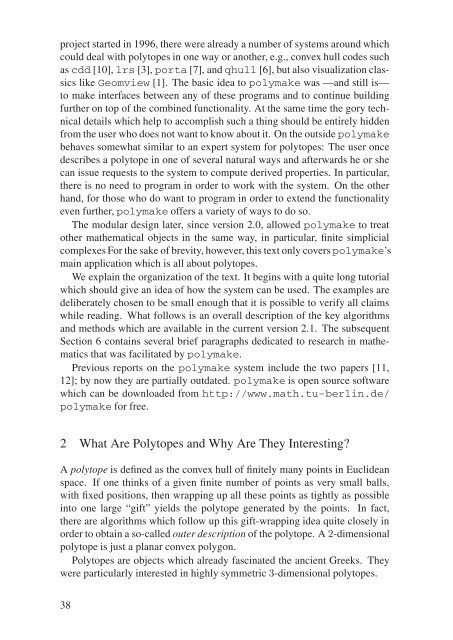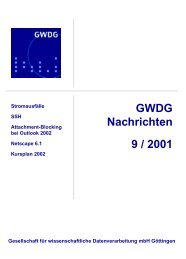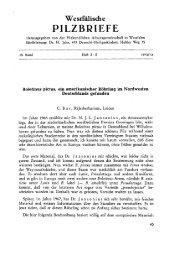Forschung und wissenschaftliches Rechnen - Beiträge zum - GWDG
Forschung und wissenschaftliches Rechnen - Beiträge zum - GWDG
Forschung und wissenschaftliches Rechnen - Beiträge zum - GWDG
Erfolgreiche ePaper selbst erstellen
Machen Sie aus Ihren PDF Publikationen ein blätterbares Flipbook mit unserer einzigartigen Google optimierten e-Paper Software.
project started in 1996, there were already a number of systems aro<strong>und</strong> which<br />
could deal with polytopes in one way or another, e.g., convex hull codes such<br />
as cdd [10], lrs [3], porta [7], and qhull [6], but also visualization classics<br />
like Geomview [1]. The basic idea to polymake was —and still is—<br />
to make interfaces between any of these programs and to continue building<br />
further on top of the combined functionality. At the same time the gory technical<br />
details which help to accomplish such a thing should be entirely hidden<br />
from the user who does not want to know about it. On the outside polymake<br />
behaves somewhat similar to an expert system for polytopes: The user once<br />
describes a polytope in one of several natural ways and afterwards he or she<br />
can issue requests to the system to compute derived properties. In particular,<br />
there is no need to program in order to work with the system. On the other<br />
hand, for those who do want to program in order to extend the functionality<br />
even further, polymake offers a variety of ways to do so.<br />
The modular design later, since version 2.0, allowed polymake to treat<br />
other mathematical objects in the same way, in particular, finite simplicial<br />
complexes For the sake of brevity, however, this text only covers polymake’s<br />
main application which is all about polytopes.<br />
We explain the organization of the text. It begins with a quite long tutorial<br />
which should give an idea of how the system can be used. The examples are<br />
deliberately chosen to be small enough that it is possible to verify all claims<br />
while reading. What follows is an overall description of the key algorithms<br />
and methods which are available in the current version 2.1. The subsequent<br />
Section 6 contains several brief paragraphs dedicated to research in mathematics<br />
that was facilitated by polymake.<br />
Previous reports on the polymake system include the two papers [11,<br />
12]; by now they are partially outdated. polymake is open source software<br />
which can be downloaded from http://www.math.tu-berlin.de/<br />
polymake for free.<br />
2 What Are Polytopes and Why Are They Interesting?<br />
A polytope is defined as the convex hull of finitely many points in Euclidean<br />
space. If one thinks of a given finite number of points as very small balls,<br />
with fixed positions, then wrapping up all these points as tightly as possible<br />
into one large “gift” yields the polytope generated by the points. In fact,<br />
there are algorithms which follow up this gift-wrapping idea quite closely in<br />
order to obtain a so-called outer description of the polytope. A 2-dimensional<br />
polytope is just a planar convex polygon.<br />
Polytopes are objects which already fascinated the ancient Greeks. They<br />
were particularly interested in highly symmetric 3-dimensional polytopes.<br />
38
















